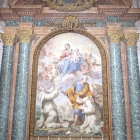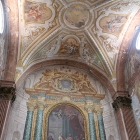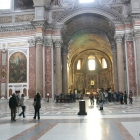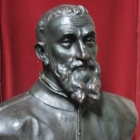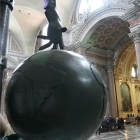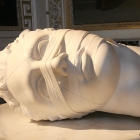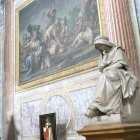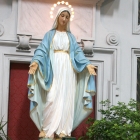Basilica di Santa Maria degli Angeli e dei Martiri
This church, found in Piazza de la Repubblica, was incorporated into the baths of Diocletian by two great architects. The first one was Michelangelo Buonarroti and the second one was Luigi Vanvitelli, the architect of Caserta Palace, near Naples. So the entrance of the church maintains the unsuspected shape of a ruin wall from an ancient Roman bath, but the interiour is at absolutely grand scale, on a cross-shaped footprint.
The church is dedicated to the Virgin Mary, to all the angels and to all the martyrs. Though death for one’s faith is not an act limited to the Christian world, the martyrs’ tradition has shaped this religion. Christians revere the early believers murdered by the Jews and Romans and consider them holy for their unshaken belief, even if they happened to be killed before being baptized.
But the persecutions against Christians did not stop in Antiquity. Even today about a hundred million Christians are subject to persecutions, which makes them the most targeted religious group in the world.
During Diocletian, around twenty thousand Christians were executed, some during gladiator games, as public display. The estimates for the entire Roman period vary a lot, to as high as a hundred thousand victims.
In modern era, atheists took Christians as their main target of repression. After the French Revolution about 30.000 priests were forced to give up their service and many were guillotined. The communists carried out the largest Christian persecution in history, in Soviet Union, China, North Korea and East European countries. Tens of thousand churches were destroyed in the Soviet Union, with the priests murdered or deported to Siberia. Only in Soviet Union, the number of Christian martyrs rose to about 21 million people. During the civil war in Spain, communists also killed thousands of clergymen.
The Basilica di Santa Maria degli Angeli e dei Martiri is also famous for the meridian line drawn on its floor, that intrigues tourists. A hole in the wall, that is part of the original Diocletian bath, allows the sun to reflect along a line on the floor. The movement of the sun allowed for the verification of the accuracy of the Gregorian calendar. The work was commissioned by the pope to Francesco Bianchini.
Mai multe despre: Italia, Religious architecture • Galileo Galilei • Italia • Italy • Roma • Rome • Santa Maria degli Angeli • Thermae Diocletiani- Home Page
start page - Architecture
landmark buildings - Sacred architecture
places of worship - Nature
landscape photography - Concert
performing artists - Christmas
Santa Claus pictures
- Jooble
jobs for photographers - Escape
an out of control blog - Merry Christmas
The best organizer of Christmas parties - Astro photo
Eclipse hunting and astrological photography


